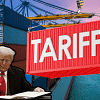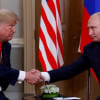The new trade disorder: US reciprocal tariffs and Bangladesh

US President Donald Trump has announced a sweeping new tariff policy under the banner of "reciprocal tariffs," marking what he dubbed the "liberation of American trade"—a radical departure from decades of multilateral trade practice—unleashing turbulence across the global economy.
In his first term as president, the United States initiated a tariff war against China, while during his last election campaign, he signalled a much wider application of retaliatory tariffs.
Even then, the extent of the latest bout of tariff slaps across so many countries has come as a major shock and is unprecedented.
The policy introduces a 10 percent "baseline" tariff on all US imports. In addition, more than 60 countries—labelled "worst offenders" for allegedly imposing higher tariffs on US goods, maintaining non-tariff barriers, or otherwise acting in ways seen as undermining American economic interests—will face higher, country-specific rates.
The newly imposed rates include 54 percent for China (factoring in existing tariffs), 20 percent for the European Union, 26 percent for India, 37 percent for Bangladesh, 46 percent for Vietnam, 48 percent for Laos, 47 percent for Madagascar, 32 percent for Indonesia, and 49 percent for Cambodia.
Once the reciprocal tariffs take effect, average US import tariffs are projected to rise more than sevenfold—from under 3 percent to 22 percent—reaching their highest level in over a century, unseen since the protectionist era of the 1930s following the Great Depression.
The Dubious Logic Behind the Tariffs
Regardless of the methodological rigour applied, the reciprocal tariffs appear to follow a simple formula: the US trade deficit with a country as a share of that country's exports to the US, halved to determine the tariff rate.
This method assumes trade deficits indicate unfair barriers, overlooking specialisation and broader competitiveness.
The policy is further undermined by its disregard for the absolute size of deficits. For instance, Vietnam and India have far larger surpluses—$125 billion and $46 billion, respectively—yet face tariffs similar to Bangladesh's, despite the latter's much smaller $8 billion surplus. Moreover, services trade is ignored, disadvantaging countries like Bangladesh that lack strong services exports.
Most economists argue that tariffs will not tackle the US trade deficit, which is rooted in macroeconomic fundamentals—particularly due to the large fiscal deficit.
According to the Centre for Economic Policy and Research (CEPR), even if the US eliminated its trade deficit by boosting manufacturing by $906 billion (a 12.6 percent increase), it would generate only 1.6 million jobs—just 1 percent of total non-farm employment.
Cross-country evidence also suggests that productivity growth, not trade imbalances, is the main driver of job losses in manufacturing.
The new US reciprocal tariffs—calculated based on bilateral trade deficits—constitute a clear violation of the World Trade Organization's (WTO) Most-Favoured-Nation (MFN) principle, a foundational rule of the multilateral trading system since the General Agreement on Tariffs and Trade (GATT) in 1947.
Under the MFN principle, any trade advantage granted to one WTO member must be extended to all others, except in narrowly defined cases such as regional trade agreements or special concessions for developing countries and LDCs.
While multilateralism has been eroding for nearly two decades, the US's sweeping and discriminatory tariffs represent an unprecedented breach of WTO norms, threatening to permanently weaken the rules-based global order.
Compounding this, the US has blocked the appointment of appellate judges to the WTO's Dispute Settlement Body since 2019, paralysing its enforcement capacity.
Although countries continue to lodge complaints, they remain stalled due to the lack of a functioning appellate mechanism.
Implications for Bangladesh and Policy Directions
With dozens of countries affected and retaliation expected, the risk of a broader global slowdown—or even recession—has grown.
Financial markets have already shown volatility amid growing uncertainty, while companies are rethinking production strategies, causing supply chain disruptions that threaten output and price stability.
The tariffs will also have immediate consequences as they raise the landed cost of imported goods, driving up US retail prices and weakening consumer demand across all supplier countries.
According to USTR assumptions, a 1 percent tariff hike raises import prices by 0.25 percent and reduces demand by 1 percent. Thus, a 20 percent average tariff could lead to a 5 percent price increase and a 20 percent drop in demand.
For apparel, however, tariffs are far above this average.
A simple mean of the new rates for Bangladesh (37 percent), India (26 percent), Pakistan (29 percent), Sri Lanka (44 percent), Vietnam (46 percent), and China (54 percent) exceeds 40 percent, implying at least a 10 percent increase in import prices—and a potentially sharp fall in US demand.
In reality, pass-through could be higher, intensifying short-term disruptions for suppliers.
Despite the 37 percent tariff, Bangladesh's relative position in the US market may hold, as China and Vietnam—together accounting for 40 percent of US apparel imports—face even steeper rates.
China's $17 billion in apparel exports and Vietnam's $15 billion are likely to decline. India may benefit most, with the lowest tariff among major suppliers, followed by Pakistan and Bangladesh.
However, Bangladesh faces a more serious challenge beyond the US as Chinese exporters redirect excess supply to markets like the EU, Japan, and Canada, competition will intensify.
With Bangladesh holding a 21 percent apparel share in the EU, this diversion could push prices down, eroding competitiveness and profitability.
The steep and uneven US tariffs also raise the risk of competitive currency devaluations, particularly among export-driven economies trying to offset lost price advantage.
For Bangladesh—already facing forex constraints and inflation—this could worsen macroeconomic vulnerabilities and complicate stabilisation efforts.
Bangladesh must reassess its position in the shifting trade landscape and adopt a balanced mix of defensive and proactive measures.
Priority should be given to targeted diplomacy with the US to seek tariff relief, possibly through concessions on American exports like cotton, LNG, or capital machinery.
However, unilaterally lowering tariffs for US goods risks violating the MFN principle and may not secure reciprocal benefits, given that the current US regime is driven by bilateral trade deficits rather than mutual concessions.
One option is eliminating para-tariffs such as supplementary and regulatory duties to show goodwill.
Yet this may have limited effect, as the US formula relies on trade deficits rather than actual tariff levels.
Another option for narrowing the trade gap is attracting US investment in sectors linked to American exports, thereby increasing US imports.
However, this approach can be time-consuming and constrained by Bangladesh's ongoing difficulties in mobilising large-scale FDI.
In the short term, Bangladesh should support exporters through temporary measures—enhanced subsidies, duty drawbacks, subsidised finance, and promotional assistance—though the government's limited fiscal space poses a challenge.
Market diversification, particularly toward the EU, Japan, and emerging economies, is critical to reduce dependence on the US, even if no other market offers comparable scale.
Medium-term competitiveness will require reforms to boost productivity, improve quality standards, and streamline logistics.
Bangladesh must also pursue FTAs with high-income and strategic markets to secure long-term access.
Monitoring the diversion of Chinese apparel exports to third markets like the EU is essential.
Early warning systems, proactive buyer engagement, flexible pricing, and coordinated industry responses will be vital to protect market share and earnings amid rising competition.
At the global level, Bangladesh should work with other affected and like-minded developing countries to revive trade multilateralism and defend a fair, rules-based system.
Collective advocacy in international forums can highlight the development costs of unilateral trade actions and push for more stable, transparent global trade rules.
The author is chairman of the Research and Policy Integration for Development (RAPID). He can be reached at [email protected]

 For all latest news, follow The Daily Star's Google News channel.
For all latest news, follow The Daily Star's Google News channel. 








Comments